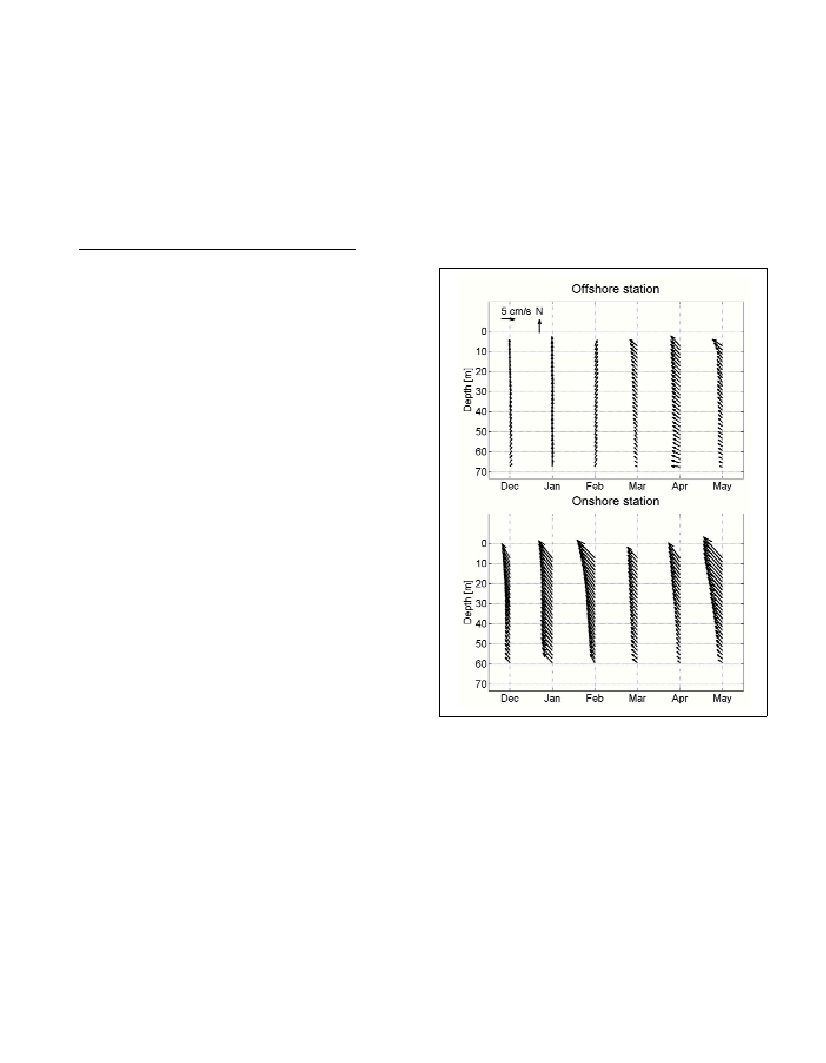Rapp. Comm. int. Mer M้dit., 37,2004
130
EAST ADRIATIC CURRENT IN WINTER AND SPRING 2003
M. Orlic
(1)
*, V. Dadic
(2)
, B. Grbec
(2)
, N. Leder
(3)
, G. Beg Paklar
(2)
, D. Ivankovic
(2)
, A. Marki
(1)
, F. Matic
(2)
,
H. Mihanovic
(3)
, M. Pasaric
(1)
, Z. Pasaric
(1)
, M. Pavic
(1)
, I. Vilibic
(3)
(1)
Andrija Mohorovicic Geophysical Institute, Faculty of Science, University of Zagreb, Horvatovac bb, 10000 Zagreb, Croatia
* orlic@olimp.irb.hr
(2)
Institute of Oceanography and Fisheries, Setaliste I. Mestrovica 63, 21000 Split, Croatia
(3)
Hydrographic Institute of the Republic of Croatia, Zrinsko-Frankopanska 161, 21000 Split, Croatia
Abstract
An experiment, comprising long-term ADCP measurements, repeated CTD profiling and meteorological data collection, was carried out
between November 2002 and June 2003 in the east Adriatic coastal waters. Preliminary findings, particularly those concerning the spatial
and temporal variability of the East Adriatic Current and its dynamics, are presented.
Keywords: currents, buoyancy forcing, winds, Adriatic.
Introduction
It is well known that the Adriatic general circulation consists of
currents ?owing into the basin along the east coast and out?owing
along the west coast, with some smaller-scale gyres embedded in it
(1). East Adriatic Current (EAC) is considered to vary seasonally,
being strongest and most wide-spread in winter, weak and narrow in
summer. Moreover, there is some evidence that the current attains a
maximum speed in a core which occurs up to Zadar, with the current
being more uniform further north.
In winter and spring 2003 an experiment East Adriatic Coastal
Experiment (EACE) was organized on a polygon off Dugi otok,
with the aim of documenting spatial and temporal variability of EAC
and understanding its dynamics. The experiment was part of a large
international effort, comprising long-term recording of currents at a
number of stations, several cruises in the North and Middle Adriatic,
and intensive program of meteorological measurements. EACE was
preceded by some preliminary modeling, which helped to organize
the measurement program in a best possible way.
The experiment
Measurements were carried out on a polygon comprising 21
stations. Currents were recorded at two stations, using barny-mounted
ADCPs, between 30 November 2002 and 14 June 2003, with a 15-min
sampling interval, bin size of 2 meters and contaminated layers of
about 4 meters. CTD profiling was done at all stations on seven
occasions between deployment and recovery of current meters.
Meteorological (solar and net radiation, air temperature, humidity,
precipitation, air pressure, wind speed and direction) and
oceanographic (sea temperature) data were collected at nearby station
Veli Rat, which was installed on 2 November 2002 and operated until
27 June 2003 with a 10-minute sampling interval. Information about
the instruments used and data taken may be found at the project web
site (http://www.izor.hr/eace).
Three Croatian research vessels (Bios, Palagruzaand Hidra) were
used in the experiment. The greatest challenge proved to be
deployment and recovery of barny-cum-ADCPs. R/V Bioshad to be
equipped with new A-frame and winch, whereupon the operations
were successfully carried out, resulting in the longest continuous
current records collected up to now in Croatia. The data are still
undergoing a detailed quality check, but some preliminary results are
already emerging.
Results
Basic statistical analysis of meteorological data reveals that both
winter 2003 and subsequent spring were anomalous: February 2003
was exceptionally cold and dry whereas spring 2003 was considerably
warmer and drier than usual. The sea responded promptly to these
weather conditions. The winter cooling resulted in lower-than-average
temperatures, which persisted in the intermediate and bottom layers
throughout the spring season. Surface temperatures gradually became
greater than long-term averages, due to intensive spring heating.
Salinities were close to the averages during winter, but surpassed them
without any sign of haline stratification during spring, re?ecting
anomalously dry atmospheric conditions, accompanied by weak river
in?ows.
Monthly mean currents measured on the EACE polygon are shown
in Fig. 1. In?ow prevailed at the onshore station throughout the six-
month interval, whereas currents were weaker at the offshore station
and did not indicate in?ow during December 2002 and January and
February 2003. Obviously, the onshore station was positioned closer
to the EAC core. The currents were almost uniform along the vertical.
Temporal variability of the currents did not follow the expected
pattern, since at the onshore station the in?ow was strongest in
February and May 2003, whereas at the offshore station it was
actually better developed in spring than in winter. Obviously, there are
two possible explanations of this finding: either it is an anomaly due
to atypical meteorological and hydrological conditions or the classical
notions on the seasonal variability are wrong.
Acknowledgement. EACE was sponsored by the USA Office of
Naval Research and Croatian Ministry of Science and Technology.
References
1-Cushman-Roisin B. et al.(eds), 2001. Physical Oceanography of the
Adriatic Sea. Kluwer, Dordrecht, 304 p.
Fig. 1. Monthly mean currents at each depth cell of the two ADCP sta-
tions, calculated over the complete months of measurement period
(December 2002 May 2003).

